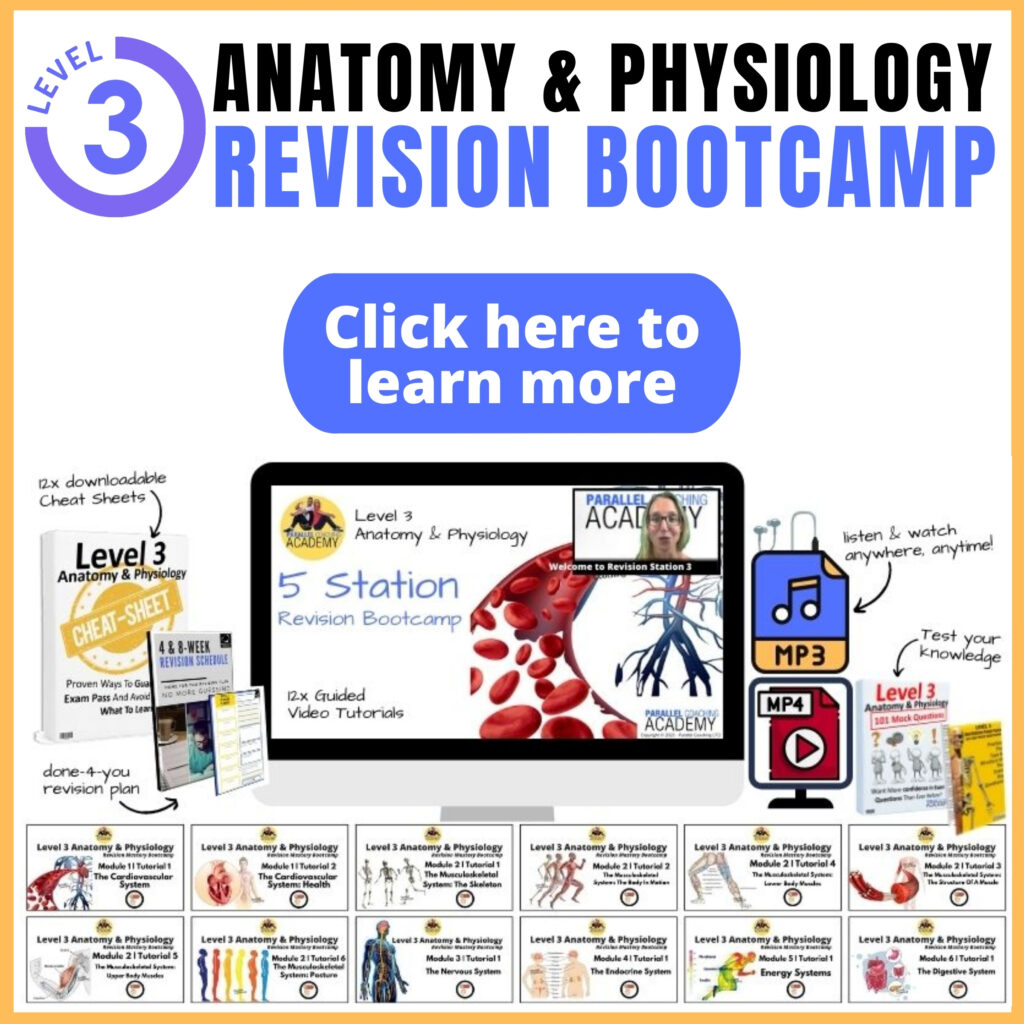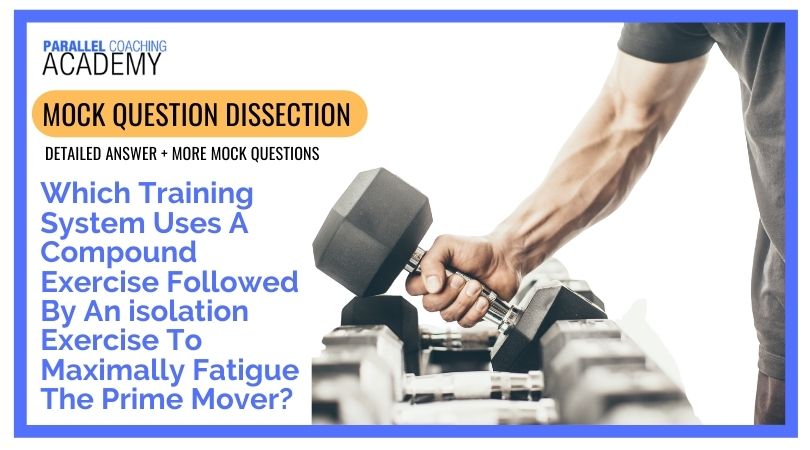This week’s edition of “mock question dissection” explores resistance training systems.
What I like about this mock question…
It links your anatomy and physiology knowledge to planning and understanding training systems.
Remember, you are training a client towards a specific goal. The client only achieves their goal through logical progressed training.
It’s the stimulus of this training that forces an anatomical and physiological adaption.
With that said…
let’s take a look at today’s mock question to dissect.
Which training system uses a compound exercise followed by an isolation exercise to maximally fatigue the prime mover?
Comment below with your correct answer:
- A. Multiple Sets
- B. Agonist-Antagonist Superset
- C. Post-Exhaust
- D. Pre Exhaust
As we dissect this mock question I want to break the rest of this blog into 3 sections:
- An Exam tip to unpick the toughest of questions.
- A brief insight into pre-post exhaust training systems.
- Why knowing and understanding anatomy and physiology is crucial in order to plan effectively.
Also, I’ve placed 3 more fitness exam mock questions below.
All relating to resistance training systems. These will help you become more confident in your knowledge and ready to tackle your final exam.
Plus make you more confident in planning for a client.
Let’s jump right into today’s revision session…
When tackling any exam mock question it’s crucial you follow the K.I.N.G.S Formula.
^^^ That’s my exam tip.
Follow this quick 5 step process allowing you to unpick every exam question.
I wrote another blog and completed a webinar about using the K.I.N.G.S Formula… the links are at the bottom in the PS section.
The K.I.N.G.S Formula
- Gets you to slow down.
- To read the question for what it is.
- To have a clear strategy to unpick the toughest of questions.
The first step of the K.I.N.G.S Formula is K for ‘Keywords’.
Finding the keywords from an exam question gives you clarity of the topics you’re being tested on.
Let’s find the Keywords in today’s mock question:
Keywords include:
The training system, compound exercise, isolation exercise, and prime mover.
Next in the K.I.N.G.S Formula is I.
What do “I” know about the keywords?
This leads nicely into section 2 of today’s mock question dissection.
Here I’ll briefly overview resistance training systems. Plus add clarity to the keywords above.
A Training system is a set of predetermined training variables.
Research shows that pre-set training systems provides a systematic approach to planning.
By progressing each training system and manipulating their key training variables, an anatomical and physiological change will take place. This is the ultimate goal of any FITPRO training a client, right?
To confidently plan logical progressed sessions that force an anatomical and physiological change in the client.
Perhaps this is for the client to become a faster runner, jump higher, or lose weight.
Regardless of the client’s goal… the only way they will achieve it is by following a logically progressed training plan.
A plan that builds in intensity.
That sees regular overload.
And more so… a plan that has training systems in it that specifically challenge the client’s anatomy and physiology in the areas required to get their goal.
For example, if a runner wants to build strength endurance in their legs.
You could select tri-sets and giant sets as the training systems in a strength rep range.
Every resistance training system has a clear outcome and benefit.
Every training system varies slightly:
They’ll vary by:
- How many exercises are in it
- How many sets are performed
- Which muscles are targeted
- How much rest is between exercises
- How much rest is given between sets
- What type of exercises are allowed
- How many joints are moving
- The plane of movement each exercise is in.
- The tempo at which exercises are performed.
This leads us nicely on to the other keywords:
compound exercise and isolation exercise.
A compound exercise is any movement where you’re using more than one joint and muscle group at a time.
Consider a squat… This one exercise sees the ankles, knees, and hips move. And engages the core, quads, hamstrings, glutes, calf muscles, and hip flexors.
Whereas, isolation exercises, only see one joint move. And therefore one or two muscles are active.
Consider the leg extension. The only joint to move is the knee and the only muscles active are the 4 quadriceps.
Above I mentioned that every training system varies slightly. One of the variables was, how many joints are moving.
Aka. is the exercise compound (multi-joint) or isolation (single joint).
It’s these two variables that make up a pre-exhaust and post-exhaust training system.
But before we dissect these two training systems and answer the mock question.
There’s one more keyword to explore and that is ” prime mover” .
A Prime mover is sometimes called the agonist muscle.
It’s the muscle that provides the primary force driving the action.
Using the Squat and leg extension exercises mentioned above. The quadriceps is the prime-mover for both these exercises.
I mentioned above… that compound and isolation variables are what govern both pre and post-exhaust training systems.
There are two more variables to both of these training systems.
- Both exercises must target the same muscle. So the prime mover of the compound exercise MUST be the same prime mover for the isolation exercise.
- The order of compound VS isolation or isolation VS compound determined whether it’s a pre or post-exhaust system.
A pre-exhaust sees the isolation exercise first, immediately followed by the compound exercise. It is very little to no rest between these two exercises. Both exercises make up this system and therefore 1 set.
For example, Pre-Exhaust:
Pec Fly Machine (isolation) > Press Up (Multi-joint) = Pec Major as the prime mover.
Leg Extension (isolation) > Leg Press (Multi-joint) = Quadriceps as the prime mover.
A post-exhaust see the compound exercise first, immediately followed by the isolation exercise. Again there is very little to no rest between these two exercises. Both exercises make up this system and therefore 1 set.
For example, Post Exhaust: (we literally flip pre-exhaust around)
Press Up (Multi-joint) > Pec Fly machine (isolation) = Pec Major as the prime mover.
Leg Press (Multi-joint) > Leg Extension (isolation) = Quadriceps as the prime mover.
Remember both exercises MUST target the same primer mover muscle.
The main benefit is fatiguing and overloading the prime mover.
You either achieve this with a pre-exhaust first by isolating the prime mover to overload.
Or with a post-exhaust by isolating the prime mover after the compound.
Respectively the prime mover is pre or post fatigued on the compound exercise.
This system encourages more muscle fibres recruitment and neural activity,
During large compound lifts, the main Prime Mover is a large strong muscle, and the synergistic muscles are supporting but weaker/ smaller. This means that the synergist will often reach overload before the big prime mover has been able to achieve full overload.
Therefore the Pre and Post exhaust systems counteract this by featuring two exercises on the big prime mover, and just one on the synergistic muscle.
For example in the Bench Press the Triceps Brachii may fatigue earlier than the pectoralis major, so add an extra exercise (before or after the bench press) that just works the pectoralis major.
Let’s quickly review the mock question again and make sure we are on track.
We can also move on to the next stage of K.I.N.G.S which is N.
What do I Need to know?
Mock question =
Which training system uses a compound exercise followed by an isolation exercise to maximally fatigue the prime mover?
We need to know which training system uses a compound exercise,
followed by an isolation exercise.
To which the prime mover is maximally fatigued.
We know training systems are grouped variables. And the variables this mock question is interested in is,
The order of compound VS isolation exercises.
Now by using the G. and S. in the K.I.N.G.S
which is Guess and Sample answers.
We can come to the conclusion that Post-exhaust is the correct answer.
Now apply this same system to the following mock questions to test your knowledge
Test your knowledge with today’s training system mock questions:
[NOTE: The answers are below the 3rd questions]
Q1: When planning a triset there are three exercises that work the same prime mover, which of the following correctly indicate a triset training system?
A. Shoulder Press, Leg Press, Press Up
B. Shoulder Press, Lat Pull Down, Lateral Raise
C. Shoulder Press, Lateral Raise, Frontal Raise
D. Shoulder Press, Press Up, Tricep Dip
Q2: What training system uses reciprocal inhibition maximally by targeting opposing muscles back to back with no rest?
A. Agonist Antagonist Superset
B. Agonis Agonist compound superset
C. Pre Exhaust
D. Post Exhaust
Q3: What Training system uses time under tension to make the lowering phase of a movement more challenging?
A. Concentric Tempo Training
B. Forced Repetitions
C. Pyramid Training
D. Eccentric Tempo Training
Answers to the mock questions are :
Question 1= C, Question 2 = A, Question 3 = D
If you want more mock questions like this, then you can download more Free Mock Questions: DOWNLOAD NOW
Need More Help with your Level 3 Anatomy Revision?
For Trainee FITPROS Taking Their L3 Anatomy & Physiology Exam.
Learn, Revise & Pass Your Level 3 Anatomy & Physiology Exam In Under 10-hours
(Without Having To Spend Hours Revising Or Feeling Overwhelmed)
If you want to get your revision structured, learn everything you need to know and feel confident on exam day, then click the link below:

Dedicated to More
Hayley “Training System Mock Question Dissection” Bergman
Parallel Coaching
P.S. You can also find us on the following platforms:
Instagram: Follow Now
Facebook: Like Our Page
Twitter: Tweet Us
YouTube: Subscribe Here
More Mock Question Blogs: HERE
KINGS Formula training HERE

